Did Republican policies create the villains in the story of the Great Depression?
World War I created a demand on Iowa farmers to produce more, even when their sons and hired help were being drafted into the army. The government appealed to farmers’ patriotism and pocketbooks. “Food Will Win the War” posters went up everywhere. Even more important, the federal government guaranteed high prices on corn, wheat and livestock. Iowa farmers responded enthusiastically, increasing their herds, putting more acres under cultivation and investing in new equipment and facilities. And production did increase rapidly. So did the price of land.
That production capacity did not go away when the war ended in 1918. Farmers continued to produce record outputs. European fields were again coming under cultivation after the war and those countries needed to buy less from the United States. American agriculture surpluses began to build up. In May 1920, the federal government stopped guaranteeing high prices, and suddenly prices for farm goods plunged. Land prices did also, and those who had speculated in rising land values were caught unable to pay off their loans. Many rural banks that had financed those loans went bankrupt, and the Midwest began a decade of hard times. Farmers continued to produce surpluses and prices sank even lower. For Iowa, the Depression did not start in 1929 when the stock market crashed. It only got worse.
Herbert Hoover Faces National Crisis
Iowa-born Herbert Hoover was elected president in 1928 as a Republican. He had a distinguished career as a mining engineer and achieved international fame and respect in leading efforts to feed starving Europeans, especially children, after the war. In 1921, he started an eight-year career as Secretary of Commerce under Presidents Harding and Coolidge. Soon after assuming office, Hoover faced a national crisis. Almost half of American families engaged in agriculture at the time. When they did not have the money to purchase manufactured items, factories couldn’t sell their products and they laid off workers. This created a downward spiral because unemployed workers could not buy products either. The trouble spread across the entire economy.
In October 1929, the value of stocks on the New York Stock Exchange started a sudden downward slide that touched off panic among investors. As in land prices earlier, there had been speculation in stocks that exceeded the companies’ capacity to produce. Banks and financial institutions that had loaned money began to fail, and credit necessary to keep the economy moving became hard to acquire.
Through Hoover’s presidency, the situation was bleak and many blamed the president. Up to one-third of the work force was unemployed. More and more families were homeless, and many young people took to the road in the desperate hope of finding work. In Iowa, farm families had the advantage of large gardens and homegrown livestock but struggled to find the cash to pay their taxes and necessary purchases. City families struggled. Before this period, welfare programs were very limited and taking government assistance was seen by many as a disgrace.
Some farmers threatened with the loss of their farms and homes became desperate. Farmers in eastern Iowa opposed a state law requiring their dairy cattle to be tested for tuberculosis. They formed gangs to threaten veterinarians doing the testing. The governor had to provide special protection for the vets. In western Iowa, farmers were so angry with a judge who refused to promise not to hear cases of farm foreclosure that they dragged him out of the courtroom into the country and threatened to lynch him. They did not carry through but the governor had to call out the National Guard to restore order. Would the country collapse into chaos?
Hoover Loses Ground, Roosevelt Claims the Election
In 1932, with Hoover’s popularity very low, the nation elected Franklin D. Roosevelt, governor of New York. He appointed Iowa’s Henry A. Wallace as Secretary of Agriculture, and Wallace quickly created a very ambitious plan to raise farm prices. Since surpluses were keeping prices low, the federal government promised a higher guaranteed price to those farmers who would reduce the number of acres they farmed and the size of their herds. This did provide some relief to farmers but, along with other federal programs, it also greatly expanded the role of the federal government that some people opposed.
The 1930s was a decade of struggle for Iowans along with the rest of the nation. In 1939, Germany’s invasion of Poland touched off a second major war in Europe. America was drawn into the conflict when Japan bombed the U.S. naval base at Pearl Harbor on December 7, 1941. Suddenly, there was once again strong demand for manufacturing and farm goods, and employment numbers rose dramatically.
The Great Depression, however, continued to have a lasting impact. Programs like Social Security were adopted to provide a safety net in times of economic stress, and individuals who had gone through the tough times never forgot it. Through the Depression and World War II, the role of the federal government grew tremendously and Iowans found themselves connected to the outside world in new ways.
Supporting Questions
Whose interests did Republican policies serve businesses, individuals or themselves?
- "A Chicken for Every Pot" Political Ad, October 30, 1928 (Document)
- Inaugural Address of Herbert Hoover, March 4, 1929 (Document)
- Letter from Arthur Smith to President Hoover, August 17, 1930 (Document)
- Letter from Herbert Hoover to Herbert S. Crocker, May 21, 1932 (Document)
Do you feel Herbert Hoover’s policies demonstrated an understanding of the plight of individuals during the Great Depression or was he a “do-nothing” President?
- Crowds Outside New York Stock Exchange, 1929 (Image)
- Herbert Hoover’s Response to Questions by the Press, October 4, 1930 (Document)
- "Bonus Army" Assembles on U.S. Capitol Steps, 1932 (Image)
- "Veterans March to Washington" Broadside, December 5, 1932 (Document)
- Dwellers in Circleville's "Hooverville" in central Ohio, 1938 (Image)
- Recovery: A Federal Writer’s Project Interview with Mr. W.W. Tarpley, January 5, 1940 (Document)
| Great Depression and Herbert Hoover Source Set Teaching Guide |
| Printable Image and Document Guide |
"A Chicken for Every Pot" Political Ad, October 30, 1928

Description
This is the advertisement that caused President Herbert Hoover's opponents to state that he had promised voters a chicken in every pot and two cars in every garage during the campaign of 1928. During the campaign of 1932, Democrats sought to embarrass the president by…
Inaugural Address of Herbert Hoover, March 4, 1929
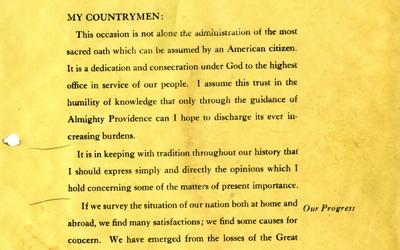
Description
Newly-elected Herbert Hoover outlines his plans for his presidency in his inaugural address in 1929. His speech included speaking about the enforcement of the 18th amendment, which would be the prohibition of alcoholic beverages by declaring the production,…
Letter from Arthur Smith to President Herbert Hoover, August 17, 1930
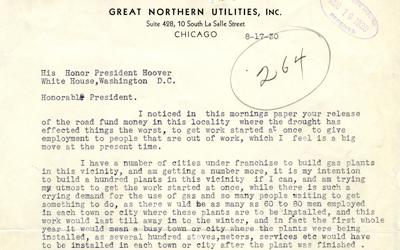
Description
The typed letter is from Arthur Smith to President Herbert Hoover. Smith was vice president of engineering for Great Northern Utilities Incorporated, and he was asking Hoover for advice on how to secure funding to build facilities in 1930. He was looking for…
Letter from Herbert Hoover to Herbert S. Crocker, May 21, 1932

Description
This letter from President Herbert Hoover to Herbert S. Crocker, president of the American Society of Civil Engineers, responds to the Society's suggestion to expand public works programs. Hoover outlines in detail his opposition to expanding public works and explains…
Crowds Outside of the New York Stock Exchange, 1929
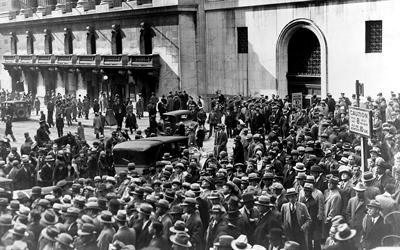
Description
The black and white photograph shows a massive crowd of people standing outside of the New York Stock Exchange (NYSE) after the stock market crash of 1929. It was on "Black Tuesday," October 29, 1929, that investors traded around 16 million shares on the NYSE in a…
Herbert Hoover’s Response to the Press, October 4, 1930
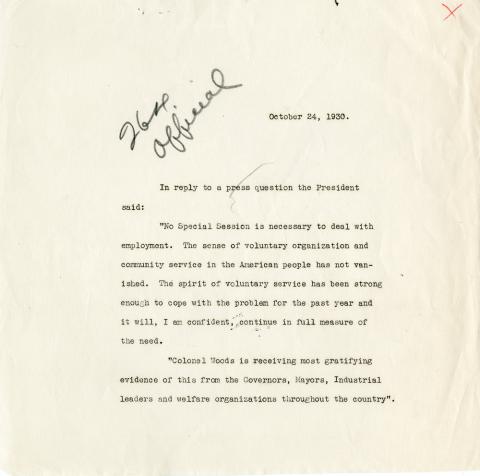
Description
President Herbert Hoover responds to a question about the need for a special session of U.S. Congress to address the issues of unemployment. The question was made by the press at a time as the U.S. economy was in a tailspin after the stock market crashed in 1929.…
"Bonus Army" Assembles on U.S. Capitol Steps, 1932
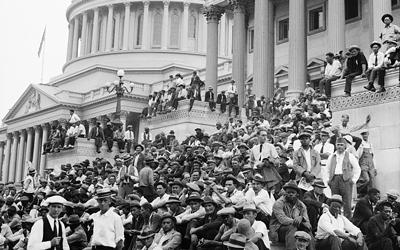
Description
The image is of a group of men, presumably part of the "Bonus Army," on the U.S. Capitol steps. This group consisted of nearly 43,000 marchers - many World War I veterans and their families - who gathered in Washington, D.C., to demand redemptions by cash payments for…
"Veterans March to Washington" Broadside, December 5, 1932
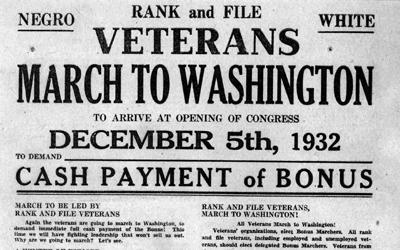
Description
The broadside - or persuasion poster - outlines the reasons veterans should to march to Washington D.C., at the opening of the U.S. Congress on December 5, 1932. The veterans were asked to march to demand cash payment of a bonus promised to veterans in 1924 by the…
Dwellers in Circleville's "Hooverville" in central Ohio, 1938

Description
The small, decrepit shack is a home in Circleville, Ohio's “Hooverville” in 1938. The image shows the exterior of the home that is typical to others of the time period during the Great Depression. As the Depression worsened in the 1930s, many blamed President…
Recovery: A Federal Writer’s Project Interview with Mr. W.W. Tarpley, January 5, 1940
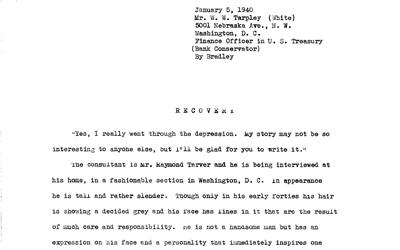
Description
In the following excerpt from American Life Histories: Manuscripts from the Federal Writers’ Project, 1936-1940, W.W. Tarver, who had worked in a bank at the time of the stock market crash in October 1929, describes how his life was changed by the…
Additional Resources:
- The American Presidency Project: Election of 1928
A map from the 1928 presidential election that shows which states voted for Hoover over Democrat Alfred E. Smith. Hoover won nearly 84 percent of the vote. - "Herbert Hoover State of the Union Highlights: 12 Quotes From Addresses"
Twelve quotes attributed to President Herbert Hoover from State of the Union addresses concerning the economy. - Herbert Hoover Political Cartoons:
- National Archives: "Bonus Army Riots in Washington, D.C., July, 1932"
Video clips of violence breaking out during the "Bonus Army" march. Video shows D.C. policemen dragging veterans from a Pennsylvania Ave. warehouse and loading them on trucks. Cavalry and tank units patrol the city and more than 43,000 march on Washington, D.C. - "Bonus Army marches on Washington, DC 1932"
Video from an unknown documentary of men, presumably part of the "Bonus Army," demanding redemptions by cash payments for their service certificates by protesting. - Library of Congress: "Encampment built by veterans in the Bonus Expeditionary Force in Washington, D.C."
The photo shows an encampment of veterans protesting in Washington, D.C. during the "Bonus Army" march. - Bonus Army Photo Galleries:
- Chicago Tribune
Photos of veterans gathering in Washington, D.C., and camping in shantytowns during the protest.
- Chicago Tribune
Iowa Core Social Studies Standards (9-12)
Listed below are the Iowa Core Social Studies content anchor standards that are best reflected in this source set. The content standards applied to this set are high school-age level and encompass the key disciplines that make up social studies for 9-12 students.
| No. | Standard Description |
| SS-Gov.9-12.14. | Analyze the role of citizens in the U.S. political system, with attention to the definition of who is a citizen, expansion of that definition over time, and changes in participation over time. (21st century skills) |
| SS-Gov.9-12.19. | Evaluate the effectiveness of political action in changing government and policy, such as voting, debate, contacting officials, campaign contributions, protest, civil disobedience, and any alternative methods to participation. (21st century skills) |
| SS-Gov.9-12.26. | Analyze the historical, contemporary, and emerging patterns of political action and activism including voter demographics, party trends over time, polling data, campaign strategies and trends, and alternative means of participating. (21st century skills) |
| SS-Econ.9-12.20. | Use economic indicators to evaluate economic conditions. |
| SS-Geo.9-12.20. | Assess the impact of economic activities and political decisions on urban, suburban, and rural regions. |
| SS-Geo.9-12.23. | Analyze the consequences of human-made and natural catastrophes on global trade, politics, and human migration. |
| SS-US.9-12.16. | Examine labor and governmental efforts to reform and/or maintain a capitalistic economic system in the Great Depression. |
| SS-US.9-12.23. | Analyze the relationship between historical sources and the secondary interpretations made from them. |
| SS-US.9-12.24. | Critique primary and secondary sources of information with attention to the source of the document, its context, accuracy, and usefulness such as the Reconstruction amendments, Emancipation Proclamation, Treaty of Fort Laramie, Chinese Exclusion Act, Roosevelt’s Corollary to the Monroe Doctrine, Wilson’s Fourteen Points, New Deal Program Acts, Roosevelt’s Declaration of War, Executive Order 9066, Truman Doctrine, Eisenhower’s Farewell Speech, Gulf of Tonkin Resolution, Test Ban Treaty of 1963, Brown vs. Board of Education decision, Letter from a Birmingham Jail, and the Voting Act of 1965. |
| SS-US.9-12.26. | Determine multiple and complex causes and effects of historical events in American history including, but not limited to, the Civil War, World War I and II, the Korean War and the Vietnam War. |
| SS-US.9-12.27. | Evaluate Iowans or groups of Iowans who have influenced U.S. History. |
| SS-WH.9-12.18. | Assess impact of conflict and diplomacy on international relations. |
| SS-WH.9-12.20. | Evaluate methods used to change or expand systems of power and/or authority. |
| SS-WH.9-12.23. | Critique primary and secondary sources of information with attention to the source of the document, its context, accuracy, and usefulness of sources throughout world history. |
| SS-WH.9-12.24. | Examine and explain how the perspectives of individuals and societies impact world history. |
| SS-WH.9-12.25. | Determine multiple and complex causes and effects of historical events within world history. |